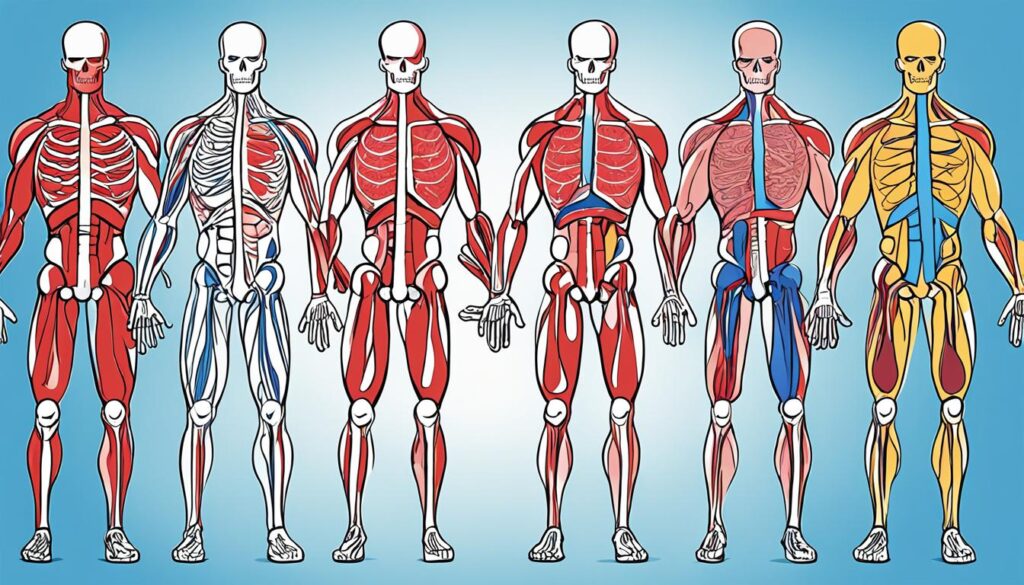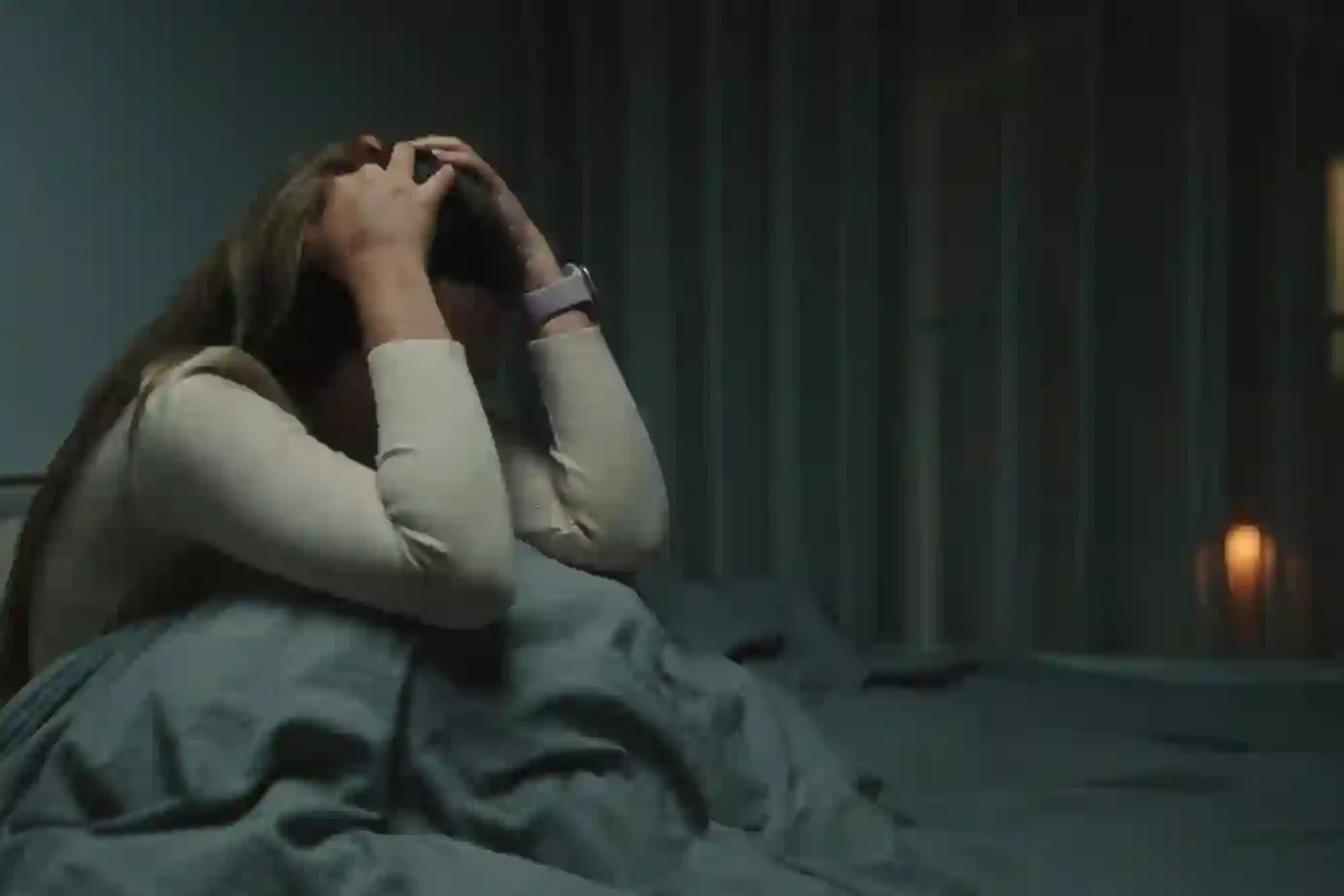Myoclonus is a unique and puzzling movement issue. It’s marked by quick, sudden muscle movements that are hard to control. These muscle jerks can happen in one spot, many areas, or everywhere on the body. This condition stands as a sign of something else going on, like certain health problems, brain issues, or changes in how the body works.
For some, myoclonus is a minor, short-lived problem. But for others, it’s a major ongoing issue linked to genes, brain disorders, or even the way the body processes things. It can also be caused by taking certain medicines. Knowing about myoclonus is key for doctors and those affected, as it can truly change how one lives.
Table of Contents
ToggleDefinition and Overview of Myoclonus
Myoclonus is when your muscles move suddenly and without you controlling it. It shows up as quick, short, lightning-like jerks. It’s a sign that something might be wrong, not a problem all by itself. This sign can point to many illnesses, and they can affect different parts of the body.
Sudden, Involuntary Muscle Contractions
These jerks happen fast and you can’t stop them. They can happen in just one muscle or a bunch of them, even your whole body. Depending on the cause, myoclonus can be a one-time thing or stick around and make life harder. Many things can trigger it, like certain genes, issues with how your brain works, problems with how your body uses energy, and even some medicines.
Diverse Causes and Presentations
Myoclonus doesn’t always point to one clear problem in your brain or nerves. It can happen for many reasons. For example, it might tag along with conditions like multiple sclerosis, epilepsy, Parkinson’s, or Alzheimer’s. Knowing the broad range of reasons for myoclonus is key for doctors to figure out what’s wrong and how to help.
Types and Classification of Myoclonus
Myoclonus can be sorted into different types to help with figuring out the issue and treating it. The main split is between primary myoclonus and secondary myoclonus.
Primary vs. Secondary Myoclonus
Primary myoclonus has a few types: physiologic, essential, and epileptic. Secondary myoclonus happens because of other health issues, like those affecting your nervous system or metabolism. It’s key for doctors to know this division to treat myoclonus effectively.
Classification by Body Distribution
Another way to look at myoclonus is where it affects the body. This can range from focal (impacting a single muscle or muscle group) to multifocal or generalized (spreading to many parts or your whole body). Knowing this helps in deciding how to best treat the myoclonus.
Classification by Neurophysiology
Myoclonus can also be split up by the brain and nervous system parts causing it. Types include cortical, subcortical, or spinal. This breakdown helps choose the right treatments because the source of the myoclonus affects what works best.
Physiologic and Essential Myoclonus
Physiologic myoclonus talks about the normal, sudden muscle twitches most people feel. Think of hiccups or sleep jerks. These quick muscle movements are a sign our nervous system is working okay. They usually don’t mean there’s a health problem.
Physiologic Myoclonus: Hiccups, Sleep Starts
Myoclonic jerks can happen one at a time or in a row. They might be rare or occur often in a minute. Such twitches are pretty common and often don’t need any special treatment, unless they start bothering you.
Essential Myoclonus: Isolated and Non-Progressive
Essential myoclonus is more of a stand-alone condition. It’s the main symptom for many, sometimes the only one. People might get this with no hints of it in their family history, which means it just happens. But it can also run in families. Usually, it doesn’t get worse over time, and it does not affect other parts of the nervous system.
Myoclonus-Dystonia: Hereditary Essential Myoclonus
Myoclonus-dystonia is a type of essential myoclonus that’s hereditary. It shows up as repetitive, rhythmic muscle twitches, often in the arms. There might also be dystonia, which twists the body into unusual positions. In some cases, it’s linked to a gene called ε-Sarcoglycan (SGCE).
Epileptic Myoclonus and Seizure Disorders
Epileptic myoclonus is a type of seizure disorder. It may involve jerking or twitching movements. These movements can be the entire seizure or just a part of it.
Myoclonus might happen alone or with other seizure types. It can also be a part of a bigger epilepsy syndrome, which includes various seizure forms.
Myoclonus as a Seizure Manifestation
Myoclonic seizures are quite common. They are often seen in juvenile myoclonic epilepsy (JME). JME accounts for 5%-10% of all epilepsy cases.
These seizures are common in generalized or genetic epilepsy. Sometimes, people with focal epilepsy have them, affecting just one side of the body.
Juvenile Myoclonic Epilepsy (JME)
JME seizures typically start soon after waking up. They often begin in adolescence or early adulthood. Sometimes, these seizures can be triggered by tiredness or flashing lights.
Progressive Myoclonic Epilepsy (PME)
Progressive Myoclonic Epilepsies involve myoclonic and tonic-clonic seizures. Unfortunately, these seizures often resist long-term treatment. Myoclonic seizures in Lennox-Gastaut Syndrome affect the neck, shoulders, and upper limbs.
Lennox-Gastaut Syndrome starts in early childhood. It is hard to manage and control.
What is myoclonus: Secondary or Symptomatic Causes
While primary myoclonus can happen on its own, secondary myoclonus comes from other health problems. The causes can vary widely. They include diseases that damage your brain, infections, and issues with your body’s chemistry.
Neurodegenerative Diseases
Neurodegenerative diseases affect your brain and nervous system. This includes conditions like Alzheimer’s and Parkinson’s. They can cause you to have myoclonus, which is when your muscles jerk without control.
Inflammatory and Infectious Conditions
Illnesses that involve swelling or are caused by germs can also lead to myoclonus. This encompasses conditions such as multiple sclerosis and certain viral infections. Rabano-Suarez P et al.’s study noted myoclonus in COVID-19 patients, shedding light on its link with the virus.
Metabolic Derangements and Toxidromes
Problems like kidney failure or certain body chemical imbalances can induce myoclonus. They hamper your body’s normal functions, creating the perfect environment for myoclonus to occur. This can lead to uncontrolled muscle jerks.
People or diseases may show more than one type of myoclonus. This overlap makes diagnosis tricky. Doctors must do a full review to pinpoint the root cause and plan the best treatment. This is key for those battling secondary or symptomatic myoclonus.
Pathophysiology and Mechanisms
The specific mechanisms underlying myoclonus aren’t fully known. But, we think several things could be involved. This includes too much activity in the motor cortex, issues with how nerve cells communicate, problems with brain chemicals, and network issues in the brain and nerves.
Hard work is being done to understand myoclonus better at the molecular and brain level. This is key for finding new ways to diagnose and treat this complicated condition.
Motor Cortex Hyperexcitability
Myoclonus might happen because the motor cortex is too active. This leads to sudden muscle jerks seen in myoclonus.
Neurotransmitter Imbalances
Imbalances in chemicals that help nerve cells talk, like GABA and serotonin, could cause myoclonus. Changes to these chemicals might affect how nerve cells talk, leading to the jerky movements of myoclonus.
Network Abnormalities
Problems with how parts of the brain work together may also cause myoclonus. When areas like the basal ganglia and cerebellum aren’t working right, it can mess up muscle control. Then, you might see the symptoms of myoclonus.
Clinical Evaluation and Diagnosis
Diagnosing myoclonus starts with a detailed and focused approach. It involves a complete history and a thorough physical check-up. Doctors look at your symptoms, past health, and anything that might trigger the muscle jerks. This first step is crucial for finding out what’s wrong.
History and Physical Examination
Your doctor will carefully study how your myoclonus acts. They note where it happens, how often, and what might set it off. They also check for any linked health problems. A detailed exam checks the body’s nervous system to pinpoint the problem areas.
Electroencephalography (EEG)
An EEG is a key tool to evaluate myoclonus. It measures brain activity, which can show where the jerks are coming from. This helps figure out the root cause and plan the right treatment.
Neuroimaging and Other Tests
Tests like MRIs can spot any brain or spine issues causing the jerks. Tests that measure muscle and nerve activity (EMG and nerve conduction studies) give more info. They help narrow down the problem and confirm the diagnosis.
A team effort is needed to diagnose myoclonus accurately. This team includes doctors, testers, and you, working together. They aim to fully understand your condition and apply the best treatment.
Treatment Approaches for Myoclonus
Myoclonus treatment is based on what’s causing it. The first step is usually using medicines. This includes drugs like clonazepam, levetiracetam, valproic acid, and 5-hydroxytryptophan to help with the symptoms.
Pharmacological Treatments
Clonazepam is a common choice to treat the symptoms. But it might make you less coordinated and tired. Other drugs, like levetiracetam, valproic acid, zonisamide, and primidone are also used. They can make symptoms better but might cause side effects like nausea and dizziness.
Botulinum Toxin Injections
For certain types of myoclonus, Botox can be a good option. This is especially true for myoclonus that affects just one part of the body. Botox injections can stop muscle spasms and help you move better. The results, however, may not be the same for everyone.
Deep Brain Stimulation (DBS)
Sometimes, myoclonus is very tough to treat with medicines. In these cases, deep brain stimulation might help. Surgeons place electrodes in the brain to change the way it sends signals. This can reduce myoclonus symptoms.
Doctors often use a mix of treatments to fight myoclonus. This might include medicine, Botox, or even surgery. By using different therapies together, they aim to make life better for those with myoclonus.

Impact on Quality of Life
Myoclonus makes a big difference in how people live. The sudden jerks and twitches can limit what they do physically. They might also feel embarrassed when this happens around others. This can lead to them feeling upset or scared, especially if the spasms are strong or stop them from doing daily tasks like eating or walking. All of this really affects how they feel and live their life.
Doctors need to look at the whole picture with myoclonus. They should work closely with the patients, their families, and other experts to come up with plans that help in every way.
This approach should fix the physical issues, help with daily tasks, and make life better overall. By looking at and treating myoclonus this way, doctors can lessen the hard impact and make life better for those dealing with it.
Myoclonus in Specific Disorders
Myoclonus stands out in some neurological diseases. This makes it vital for doctors to know its many forms. In Creutzfeldt-Jakob disease, myoclonus can appear as “startle myoclonus.” This means that sudden muscle jerks happen when something unexpected touches the person.
Creutzfeldt-Jakob Disease and Startle Myoclonus
The “startle myoclonus” is a key sign of Creutzfeldt-Jakob disease. This condition is very serious, caused by damaging proteins in the brain. The muscle jerks happen quickly and affect daily life. It’s hard for people with the disease and those who care for them.
Myoclonus in Multiple Sclerosis
People with multiple sclerosis often experience myoclonus too. This is a long-term disease where the body’s own defense mistakenly attacks the nervous system. Specific damage in the brain and spinal cord leads to jerks in the muscles. Knowing why and when this happens can help control the symptoms better.
Other Neurological Conditions
Myoclonus isn’t just in Creutzfeldt-Jakob disease and multiple sclerosis. It’s also found in other illnesses like Parkinson’s and Alzheimer’s. These are diseases that damage the nerves. Others, like paraneoplastic syndromes, come from the immune system going after the body. Knowing these signs helps doctors make the right calls and treat patients effectively.

Conclusion
Myoclonus is a diverse movement disorder. It causes sudden, involuntary muscle contractions. These can vary from mild and temporary to severe and ongoing. The reasons can include things like issues with the brain, metabolism, or infections.
Dealing with myoclonus needs a combined effort. This includes checking symptoms, doing tests, and creating custom treatment plans. Health professionals need to be alert to the signs of myoclonus. They should work closely with patients to make care plans that help in many ways.
Myoclonus can really change how a person lives their life. But, research and new findings are helping us understand it better. With the knowledge of the latest updates, doctors and others in healthcare can offer better care. This leads to better results and a better life for those with myoclonus.
In summary, myoclonus is a complex issue that affects people in many ways. Knowing the recent findings in research and care is vital. It helps in offering full and supportive care to people facing this challenging condition.
FAQ
What is myoclonus?
Myoclonus is a movement disorder that makes muscles contract suddenly. These contractions are fast and feel like a surprise. They could happen in one muscle, several, or across the whole body.
What are the different types of myoclonus?
There are two types, primary and secondary. Primary myoclonus is not caused by another health problem. It includes different forms like physiologic and epileptic. Secondary myoclonus is due to other conditions, such as neurological or metabolic issues.
What causes myoclonus?
Many things can lead to myoclonus. It could be genetics, a neurological disorder, or a reaction to medications. The impact might just be temporary, or it could be a long-term struggle.
How is myoclonus diagnosed?
Diagnosing myoclonus starts with a detailed health history and exam. Doctors may do tests like EEG or imaging scans. These help find the root of the problem.
How is myoclonus treated?
Treatment depends on what’s causing myoclonus. Doctors often use medicines like benzodiazepines. Sometimes, botulinum toxin or deep brain stimulation is an option.
How can myoclonus impact a person’s quality of life?
Myoclonus can make daily life hard if the muscle twitches are frequent or strong. It’s important for health teams to help patients cope by considering their emotional and social needs.
Can myoclonus be a feature of other neurological conditions?
Yes, it can be linked to other conditions like Creutzfeldt-Jakob disease. Knowing how it acts in each condition is vital for correct treatment.
Source Links
- https://www.ncbi.nlm.nih.gov/pmc/articles/PMC8370153/
- https://www.mayoclinic.org/diseases-conditions/myoclonus/symptoms-causes/syc-20350459
- https://www.ninds.nih.gov/health-information/disorders/myoclonus
- https://www.ncbi.nlm.nih.gov/pmc/articles/PMC3036960/
- https://www.bcm.edu/healthcare/specialties/neurology/parkinsons-disease-and-movement-disorders/myoclonus
- https://my.clevelandclinic.org/health/diseases/23172-myoclonic-seizure
- https://www.epilepsy.com/what-is-epilepsy/seizure-types/myoclonic-seizures
- https://www.ncbi.nlm.nih.gov/books/NBK537015/
- https://www.mayoclinic.org/diseases-conditions/myoclonus/diagnosis-treatment/drc-20350462
- https://www.ncbi.nlm.nih.gov/pmc/articles/PMC3899494/
- https://www.beaconhealthsystem.org/library/diseases-and-conditions/myoclonus?content_id=CON-20155102
About The Author

This article is medically reviewed by Dr. Chandril Chugh, Board-Certified Neurologist, providing expert insights and reliable health information.
Dr. Chandril Chugh is a U.S.-trained neurologist with over a decade of experience. Known for his compassionate care, he specializes in treating neurological conditions such as migraines, epilepsy, and Parkinson’s disease. Dr. Chugh is highly regarded for his patient-centered approach and dedication to providing personalized care.
→ Book a consultation to discover which remedies suit your needs best.




